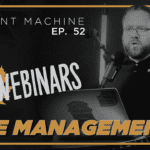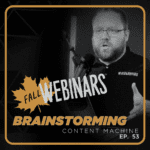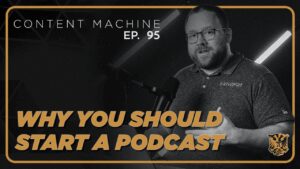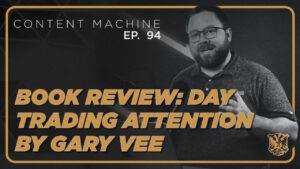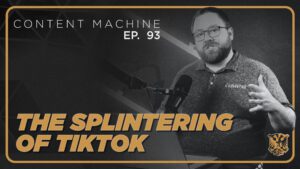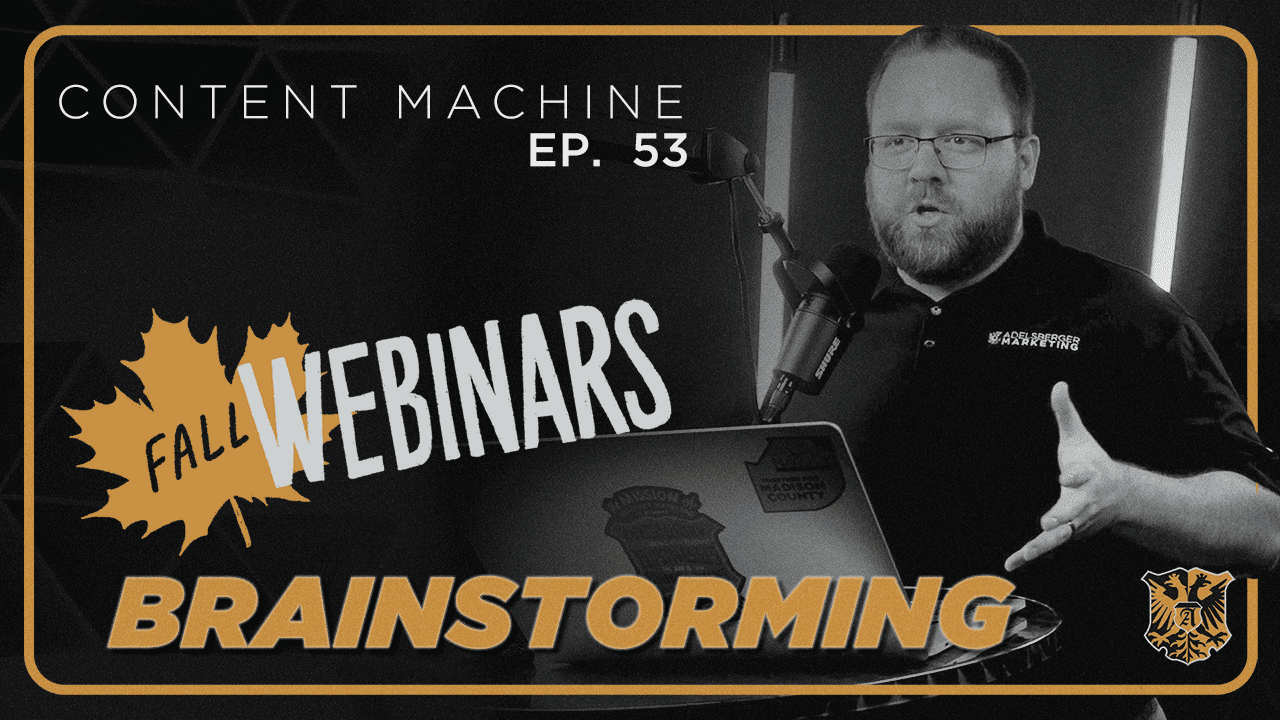
Yeah. So let’s dive into brainstorming. We love brainstorming at Adelsberger Marketing. It’s one of the things that we do with all of our clients to make sure that we’ve got fresh content and good ideas moving forward. And so we’re going to walk through our framework for it and then some details on the actual exercise and then some practical how-tos on the back-end. Once again, feel free to put your questions in the chat section, and we’ll just dive on it then with the framework. When we think about the framework, we’re thinking about the who, what, when, why, and where for something like that. We’re going to start with the who. This is actually a picture of us doing a brainstorming engagement with a small bakery here in Jackson. When we start with the who of a brainstorming session, we need to make sure the right people are at the table. What does that mean? There’s really three groups of people that I think need to be represented at a brainstorming session. Sometimes these groups of people cover multiple categories. But when we do a brainstorming session, the first thing is, are the right stakeholders at the table?
Or in this case, the insiders? These are people who care about the organization. These are people who understand how things work on a day-to-day level in the organization. And they’re people who have a vision for where the organization can go. You want to have people at the table that care about the place, that understand some of the details, because as an outsider, like I am to most of these situations, my concept of how things might work might be a little bit less connected to reality than it actually is. Then frequently, the best people at a brainstorming session are insiders or stakeholders who also think about the organization as a whole and maybe not just about their job and think about vision for the organization. The second group of people on the who is who are outsiders. Outsiders that are involved in the strategy session can bring a lot of value to the table. Why is that? Well, when we’re talking with just insiders, sometimes we’re talking about things from a five-foot view, like we’re looking at the grass. As a consultant or an outsider, you can get further perspective from the problem. We’re maybe not caught up in the politics of the organization or some of the issues that are currently existing in the organization.
While you might be looking at blades of grass from a five-foot perspective, a consultant can come in and see the entire map. And so that gives an outsider consultants or outsiders as in team members that aren’t in that department, or maybe that are on the board of an organization can help give better framework for who needs to be involved. And then finally, leadership from that organization needs to be involved. People who can make the decisions that are going to implement these things can be really helpful to have in these situations. They might not always contribute a lot, and sometimes they contribute too much, but we need people to be bought into the process so that when they are ready to start implementing these things, they have an advocate in the company. The second thing when we think about the who, what, when, why, and where, is we want to make sure that people have the permission to think. Do people in your culture have permission to speak and share ideas? I don’t really love the phrase safe space, but this is kind of an applicable concept here. It’s like, are people enabled and encouraged to have permission to, frankly, be able to say, Hey, I don’t think this is working really well, or, These are things that are going well.
And occasionally, I’ve seen organizations where there’s people who care and they’re not able to speak freely, and that’s a bad recipe for a brainstorming session. So does the culture of your organization allow for ideas, or do leadership just shut people down? This is something that I have to work on a lot as a business owner, is making sure that I’m encouraging my people to share. One of the helpful tools in that comes from the world of improv. Instead of saying but to a question, so we’ve got our team will come up with ideas for things in our brainstorming sessions. And my first instinct is to say, Well, but this won’t work because… And so in the improv world, the rule is yes, and. So instead of saying, But I have a problem with that, you can say yes and and help pivot that idea or add to that idea. It can be really dampening to a session when a leadership team is crushing ideas in a phase that they’re not supposed to be crushing ideas. I’m guilty of this as well. Something I have got to work on this on a regular basis is making sure that I’m saying yes and…
We’ll talk about this more in a second. We’re not here to talk about detailed implementation things because there’s going to be lots of issues and sticking points in detailed implementation. But we want to somehow… We’ll merge that gap in a little bit, but at the early phase, we want to make sure that people have the freedom to put ideas out there to get things going. Another thing that is helpful to setting people up is inspiration. Inspiration. And so inspiration is a component that allows us to just get the brain flowing a little bit. We love watching fun, creative YouTube videos at the beginning of a brainstorming session or after a break at a brainstorming session. It gives us an opportunity to just think about the world a little bit differently. And so we always start with an interesting video. And then the other thing is, as we think about permission to think, we also love prompts at our company. So instead Instead of just saying, Here, brainstorm about this, most of our brainstorming is around marketing and messaging and content ideas. We have some prompts here that we use. This is actually a slide that we use in our strategy sessions where these are four prompts that we use to help people think about ideas that will be helpful.
Because sometimes we did a competition at a company baby shower yesterday where it’s like, name the whomever can list the largest number of songs that involve the word baby. And that’s all well and good, but it’s difficult to do not in context. And so later, I wish I had just thought I should just focus on nativity songs and just go through every Christmas song that I could think of because that would have been a prompt for me. That would have been more successful. I did lose that game. These are four questions that we love. My favorite one is if I had a million dollars. This works in a lot of brainstorming sessions. It’s like, Okay, if you had a million dollars to do this, to solve this problem, what would you do? The great thing about the million dollars is it really opens people’s brain. Then you can scale it back or think of creative ways to execute those things. My team laughs because in every brainstorming session, my answer to if I had a million dollars is I would buy a blimp. I would buy a marketing blimp, and I would fly it in front of my customers’ offices to promote their businesses because it would be hard to ignore, and it would be a lot of fun to do.
The next part of that format is when. When should you do a brainstorming session? Well, I think two or three answers here. One, if you don’t have a specific goal in mind, but you’re wanting to make plans for the future, a regular basis is a good thing. We do one every quarter for all of our clients that we have reoccurring marketing for. But if you’ve got something coming up that you need to brainstorm about, so it’s like, let’s say you have a big event or you’re getting ready for your annual planning for the next year, what are things you need to think about? Well, let’s do it far enough in advance that we can put these plans into place. A couple of months in advance But sometimes you’re going to have urgent ASAP things, and so then it’s like you get it on the calendar as soon as possible. But my advice there is that you have a very targeted approach for what you’re brainstorming about. Brainstorm about a thing and be practical in that brainstorming session, and you’ll be setting that table. We’ll talk about that more in a second. Then where? Where should you do a brainstorming session?
You can literally do a brainstorming session anywhere, but the best ones are going to be a place where you can focus. Off-site is great because off-site brings less distractions for people, and it could help just make your brain feel a little bit more creative being in a different environment. Then you want to cut out distractions because, and as I like to say, distractions are death. And so can you be in a place that you’re going to not have distractions? Can you ask everybody to turn their phones off? Can you make sure that their laptops, if they’re using laptops, are not pinging every time they get an Outlook message in or you turn off Slack? Being able to cut out the distractions and stay in the moment and stay alert and focused on what you’re brainstorming on is going to pay benefits. Along with that is making sure where you’re at has coffee and snacks or caffeine and snacks. Potentially, some background music is good. We love like, Lo-Fi playlists, Lo-Fi beat playlists on Spotify and things of that nature. And then another component is you want to have walls, and we’ll talk more about Post-it notes in a minute.
We like using walls, and whiteboards are a lot of fun as well. So if you have a place that you can be quiet, it can be quiet around you, you can cut out distractions, and you can have coffee and snacks and walls and whiteboards, you’re You’re set up for a good time. And then the final part of that format is why. When we think about what makes a good subject, we want to make sure that we’re setting people up to be successful in these brainstorming sessions. How do we do that? Well, one, we have a clear point of focus. Now, it may be content that you want to generate. It could be marketing strategies. It could be new customer recruitment. It could be what are ways that we can facilitate referrals from one business to another. So a clear point of focus is very helpful for people. I believe strongly that everybody is creative. And the best people who are creative paint to all the corners of the box that they’re working in. Because if you don’t have a box to work in, you’re going to paint on all sorts of things that don’t affect what you’re trying to do.
And so we need to make sure that we communicate what that box is for the brainstorming. And so if we’re talking about new customer recruitment and you’re focused on brainstorming about safety methods at your office building or in your driving for your company, you’re going to be a little off base and not super productive for that. So having a clear point of focus and helping paint the box that people are going to be looking at is important. And then from there is clearly communicating the subject or the problem. You’re laying helpful groundwork so that people can approach it and understand what’s happening. If you are talking about that customer referral problem, you need to make sure that people understand where you’re at, how you’ve gotten here, things you’ve tried already, and people that you’ve worked with. Helping them ask any questions ahead of the time before the brainstorming starts can help them focus and have a clear thought. Then you want to understand the goals of the session. Is the goal to come up with a bunch of ideas? Is the goal to create a proposal to bring to a new set of people?
That will help some of the next components when we talk about what we do with all these ideas. But being able to communicate all that ahead of time is super helpful for people. All right, moving right along here. The main exercise. So now we’re going to walk through the actual mechanical parts of how we do a brainstorming session. So these sessions to do them well, it’s like working out a new muscle. It takes time to strengthen that. I agree with you, Mark. I think everyone is creative. I work with a lot of accountants. They tend to say they’re not creative, and I think that’s a lie. But in my business, in our marketing business, we’re very incentivized to use our creative muscles on a regular basis. Other businesses, not so much. We’ve worked that muscle out, we flex it, and we have tools in place to help us do it better. We love to use post-it notes in our brainstorming session. If any of you have been a part of a brainstorming session, you’re likely have used post-it notes. How do we use post-it notes? Well, one, we put one idea or phrase per post-it note, and we use Sharpies.
Why do we use Sharpies? This came from William Donnell. Let me give him credit for that. If you have a Sharpie, you’re less likely to write a novel on your post-it note than you are with a pen. And so sharpies help us write less and write larger, but also make it more visible from a distance. So if you’re in a conference room and all the ideas are on the wall, like behind me, being able to see those from a distance is very helpful. So how do we put one idea or phrase on a Post-it note? Let’s talk about if we were to be using pizza toppings, for example. If I was to ask you to write one idea or phrase for post-it note, let’s start with your favorite pizza toppings. This would be the wrong way to do it. In some people, there’s inevitably almost one person in every session who does this. But you want to not list them all on one post-it note. Listing them all on one post-it note is problematic for a few reasons, which we’ll go to in a second. The proper way to do it is to say, Okay, I’ve got pepperoni.
I like pepperoni, I like cheese, I like mushrooms, I like tomato sauce. Just to be clear, this is not actually my list because I don’t like mushrooms on my pizza. But then what you end up with is you’ll have four different post-it notes that you can use with the team, and we’re going to talk about how we use that in a minute. That’s an important structure component on using your Post-it notes correctly so that you’re able to get your ideas out and be seen by people. Now we’re back to the post-it notes. Why do we do that? One, They’re easy come, easy go. We can throw Post-it notes away. If you get stuck, you can draw a picture while you wait, or if you misspell something, you can throw a Post-it away. Not a big deal. It gets everybody’s ideas out on the table. In some organizations where there’s a heavy leadership perspective that can be hindering to other people participating. And some people, I’m a very loud person. For those of you that you’ve been in meetings with me, I’m not afraid to have my voice heard, whether I’m right or wrong. And some people are less willing to speak up.
Having a set up with this Post-it Notes allows everybody an equal playing field to getting their ideas out. It also allows us to do some group sorting so that we can see groups of ideas and sort things to see if there’s themes that are coming up in different areas. And then it also helps us to be able to have individualized ideas in a tactile way that people can engage with on the wall. And so if we were to do the structure and timeline, here’s what we like to do. So we’ve gone through what our concept is. We’ve gone through the box we’re coloring in. We’ve gone through some of the background, and everybody has Post-it notes and Sharpies. And we like to say, Here’s two minutes, here’s some prompts. Go through that. And it gives everybody a chance to put out Post-it notes. Maybe it’s pizza toppings, or maybe it’s like, Who are your biggest competitors in this space? Sometimes everybody answers the same thing, but usually one or two people speak up in a way that wasn’t featured previously. We then sort those ideas. In our instance, when we give our team time to come with a big scope of ideas, they’ll come up sometimes with three, sometimes they’ll come up with 15.
We actually limit what we submit to the group so that we can maximize our time together, and we have people sort them into their top three, two or three ideas to share But then we also, if we’re in a group situation where we’re hearing from the customer, we’ll put all the ideas up on the wall, and then we’ll help group those by theme, if there’s a theme. And then also that could give us an opportunity to vote on those, and we’ll talk about those more in a second. We’ll discuss them as we go up, especially if it’s a concept that is new. If we’re talking about a new content idea, we would have someone like, Hey, you wrote X on this card. We don’t really know what that means. Can you help elaborate a little bit as we put it up on the wall? That helps us all get a little grasp of what they’re talking about. Then if we’ve hit on a theme that we need to expand upon or we see by the ideas that someone missed the concept, or we want to drill in on one idea that was like, Everybody talked about introducing a video for this customer, but we didn’t get into what type of video it is, we’ll then have a second brainstorming component under for two minutes or whatever, talking about concepts for that video.
Everybody then is submitting, Okay, these are ideas for the video. We all want to do a video. These are ideas on what the video should be. Now, there’s two exercises I’ll recommend here if you’re thinking about doing a brainstorming session. One is broad context. When I say broad context, I mean like, Hey, let’s all write down what we think are ideas that we need to work on improvement with, or what are things that are biggest issues? I want everybody to list what our biggest issues as a company are, which could be a really dangerous question. Or it could be like, Okay, we want to do marketing this year. What are some ideas for marketing? Very broad. Another activity that we What we really like is our sailboat activity. It’s not necessarily our sailboat activity, but it’s a pretty common brainstorming exercise. In a second, I’m going to put a QR code up and you can download a PDF with this graphic so you don’t have to try to steal the screenshot or anything. Katie Hauerton on our team did this art. It’s really good. But when we look at the sailboat exercise, we look at four different things.
One, what is the wind in our sails? What are the things that are going really, really great right now? How What is this pushing us forward? Is it like a referral business? Is it our team that’s really crushing it? Is it like the mission of organization? Everybody aligned on that. What are the things that are helping push us forward? Two, what are the anchors? What are the things that are internal factors that are slowing our company down. We were working with a group recently, and it turns out that there was a HR structure issue that was really hurting the hiring process. We had a really robust discussion about it that we felt like was a helpful thing for the other organization. Not directly marketing-related, but a lot of times we find in these conversations, there’s things that come out of these that aren’t marketing-related that can really help the company thrive. Anchors are internal issues that are slowing down the company. Then we go to Rocks. Rocks are external factors that are dangerous to the company. That may be competition, that could be legislation, that could be a lot of different things. We want to get those out on the table so we have an idea of what those might be.
Then finally, the island is like, What is our ideal? That’s where we’re wanting to go. What’s our ideal situation? We’re trying to get there. This activity, I’ll put this QR code up on the screen if you want to download the sailboat PDF. The great thing about the sailboat activity is as an outsider, it helps us get some better grasp of things that are going on inside. But then also between the people in the company, depending on who’s in the room, it can also create an to share something that maybe people didn’t know about in the past. They might not have understood that the rock, the anchor, was something that people viewed as an anchor, and they’re like, Well, we can change that. So it creates a good opportunity for speaking. We’re going to talk about what to do with these ideas in just a second. I’m going to take a second just to promo us just a little bit. Most of you on this know who we are. But even if you know who we are, I want you to know we have a podcast that we put out on a regular basis that has helpful content for marketing and leadership and culture development at a company.
Every month on the second Tuesday of the month or second Wednesday of the month, I do an Office Hours with the Co. You can sign up for that at the Co. What is that It’s a free 30-minute window to get marketing consultation. If you have some questions that you want to talk to me about marketing, you can sign up for that. It’s free. It’s through the Co. It’s awesome. Then we have one more webinar coming up on on December fifth. It’s the 90-day content plan. We’ll touch on a little bit on brainstorming on December fifth, but we’ll be talking about practical steps about focusing that on content generation, and then how do we build a calendar from that. Then also, just so you know that we do marketing. We do design and video and websites and marketing services in general. Since you’re here, you get to hear that pitch. All right, so let’s talk about what do we do with all these ideas. You and your team or you your organization have just done brainstorming, and you’ve got a lot of Post-it notes on the wall. There’s a lot of different ideas. How do we do with those?
Well, first thing that I recommend is that you collect those ideas, reference them, put them all in a Google Doc or Excel note that everybody can access. We love Google Docs because everybody can edit that. And we like to keep them as a list. And I reference those lists very regularly, especially when we do content meetings, I will reference that note before I meet with the customer the next time to go through what was our top ideas and what are some other things that we should be thinking about with them. Keep those there. The second thing would be is to sort those ideas. There might be similar ideas sorted. There might be some themes, like let’s say video or let’s say the sidewalk at our business is broken up and cracked up and everything. And so think about those themes and see if those themes require further brainstorming. When you get within that, you can rank and vote ideas as well. We like to do this a couple of different ways. The biggest way is with our post-it notes on the wall, with them grouped, we I’ll give everybody a sheet with stickers on it.
That sheet with stickers, like the little dots or stars, like metallic stars that we all got as well. I say we all got. I got very few, but hopefully everybody We got some on good behavior charts in school. Then everybody gets a couple of those stars or a couple of those stickers, and they can upvote their ideas a little bit like Reddit. The groups that have the most stickers on them are people indicating that these are valuable or important to them. That can help because depending on how many people you have participating, you might have 50 ideas on the board. Getting the company to buy in on those ideas and knowing that three-fourths of the group are excited about this particular idea is really important. The second component that when we think about what we do with these ideas is working on mapping out effort and impact. This next grid is something I’ve borrowed from a few different places. But this impact and effort grid is a great tool to help focus what your next steps should be. There’s four categories here, two Two good categories, two bad categories. The worst one is filler tasks in my book.
Filler tasks are things that are… Actually, hard slogs are probably the worst, but filler tasks are something that’s easy to do but also has very little impact. Now, sometimes you need filler tasks to help keep people busy or to help produce a little bit of content to keep your social media active. Hard slogs are high effort, low impact. Actually, hard slogs are the worst ones for sure. You want to avoid those. And it’s important to be honest from a group perspective as you put ideas on this grid. We actually use a whiteboard to draw this grid out. Then we put, as people bring their top ideas, we help sort those into these categories. Hard slogs are something that you need to be honest about and you want to avoid if you can. Quick wins are the gold category here. It’s high impact, low effort. These are things that you want to implement right away because you can do it tomorrow and it should have a big impact for the company. Of course, big projects are high impact, high effort. Not to say that they aren’t doable. Starting a new website project is a big impact, big effort, and you can’t do it tomorrow.
It’s going to take some time. But it’s something that we need to understand what the true cost of this is before we pursue it. I would also add that between these four categories, in our sessions, we don’t allow the person to rank their own idea. We have the crowd help rank that because there could be things that you may not understand. For example, let’s go back to video. We do a lot of video production. Someone might say, Hey, let’s do a motion graphics video talking about these things. That person doesn’t make the motion graphics video, so they’re maybe not understanding all the components that move it from a quick win to a big project. Being able to talk about these and help the ideas get into the right spots on the grid is super important. Then the next thing from there, once we’ve got these ideas sorted, is there could be an opportunity for round two to iterate on an idea. We talked about this a minute ago with the video component where people might say, Hey, we want a video, and then we brainstorm on what that video is. But in this category, when we’re looking at the impact and effort grid, we might want to iterate, which is to come up with new versions of things that are in the big project or the quick wins category.
If there is a content idea in the quick wins category, it may be worth talking about as a team. It’s like, Okay, what are different ways that we could do this to make a good execution? Then the last phase of what to do with this idea is the thing that irritates me the most in the world is when I meet with someone or we present ideas to a company and everybody’s like, Yeah, let’s do it, and then they never do anything with it, or we do a consultation, and then they just leave it on the table. I got super excited a few weeks ago. We presented a strategy session to a customer, like the results of it. Since the strategy Some ideas come out in the strategy session, and then we come back and talk about details. Between the time of having the strategy session and going and presenting was about a four-week time period because of schedules. They had already started acting on ideas that we had talked about in the strategy session. That’s my drug of choice is people putting into action what we’ve been talking about in a marketing sense. It was a lot of fun.
The next component is, how do you take detailed implementation steps to make this a reality. If you’ve got your high impact activities, you need to assign those to a person. You need to assign a timeline to those. You need to break down those steps to make it a reality. That can be done as a group as well, depending on how much time you have as a team, is to say, Okay, we’re going to work on these three ideas that everybody voted on, that are the three ideas in the quick wins or the big projects category. What do we need to do to make this reality? The who and the what and the when and the why and the where are super important to turning those ideas into reality. And that’s where the magic hits the road. One thing we’ve been really encouraging people to in last year is look at EOS I know, I see Sabrina is in here. Eos is at Huntsville Coca-Cola. We’ve been recommending it to a lot of people because it’s a great way to take ideas and turn them into action. It’s a 90-day mentality of like, Okay, We’ve got these 10-year goals, which work into one-year goals, and how do we make progress on those in a 90-day window?
That’s an idea that we’ve been really pushing with our customers this year because Because EOS can really work with us as well, working with us. Thinking through the detailed implementation, how to make things a reality, is the last thing that you do with those ideas. Being able to revisit those ideas in the Google Doc or having some follow-up meeting to have accountability on that is super important. That’s the webinar on brainstorming. We talked about the framework and making sure people have permission We’ve talked about the main exercise and how that works out in a practical manner. Then we talk about what to do with these ideas once we’ve generated them. Got a minute for questions here. If anybody has any, you can put those in the chat. But if not, we would invite you back to our next webinar, which is our 90-day content plan. That’s on December fifth at 11:30. There’s no other questions. I’m not seeing anything coming through, but I appreciate all of your time. I’m glad that you all were here, and I hope it was beneficial. If you ever… We do offer a brainstorming service for people, but we can talk about that a later time if you want to.
Thank you all for your time, and I hope you have a great day.

